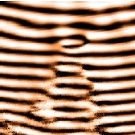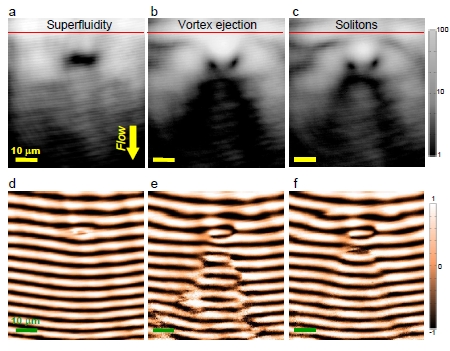https://johncarlosbaez.wordpre…/2011/11/28/liquid-light/
Liquid Light
Elisabeth Giacobino works at the Ecole Normale Supérieure in Paris. Last week she gave a talk at the Centre for Quantum Technologies. It was about ‘polariton condensates’. You can see a video of her talk here.
What’s a polariton? It’s a strange particle: a blend of matter and light. Polaritons are mostly made of light… with just enough matter mixed in so they can form a liquid! This liquid can form eddies just like water. Giacobino and her team of scientists have actually gotten pictures:

Physicists call this liquid a ‘polariton condensate’, but normal people may better appreciate how wonderful it is if we call it liquid light. That’s not 100% accurate, but it’s close—you’ll see what I mean in a minute.
Here’s a picture of Elisabeth Giacobino (at right) and her coworkers in 2010—not exactly the same team who is working on liquid light, but the best I can find:
How to make liquid light
How do you make liquid light?
First, take a thin film of some semiconductor like gallium arsenide. It’s full of electrons roaming around, so imagine a sea of electrons, like water. If you knock out an electron with enough energy, you’ll get a ‘hole’ which can move around like a particle of its own. Yes, the absence of a thing can act like a thing. Imagine an air bubble in the sea.
All this so far is standard stuff. But now for something more tricky: if you knock an electron just a little, it won’t go far from the hole it left behind. They’ll be attracted to each other, so they’ll orbit each other!
What you’ve got now is like a hydrogen atom—but instead of an electron and a proton, it’s made from an electron and a hole! It’s called an exciton. In Giacobino’s experiments, the excitons are 200 times as big as hydrogen atoms.
Excitons are exciting, but not exciting enough for us. So next, put a mirror on each side of your thin film. Now light can bounce back and forth. The light will interact with the excitons. If you do it right, this lets a particle of light—called a photon—blend with an exciton and form a new particle called polariton.
How does a photon ‘blend’ with an exciton? Umm, err… this involves quantum mechanics. In quantum mechanics you can take two possible situations and add them and get a new one, a kind of ‘blend’ called a ‘superposition’. ‘Schrödinger’s cat’ is what you get when you blend a live cat and a dead cat. People like to argue about why we don’t see half-live, half-dead cats. But never mind: we can see a blend of a photon and an exciton! Giacobino and her coworkers have done just that.
The polaritons they create are mostly light, with just a teeny bit of exciton blended in. Photons have no mass at all. So, perhaps it’s not surprising that their polaritons have a very small mass: about 10-5 times as heavy as an electron!
They don’t last very long: just about 4-10 picoseconds. A picosecond is a trillionth of a second, or 10-12 seconds. After that they fall apart. However, this is long enough for polaritons to do lots of interesting things.
For starters, polaritons interact with each other enough to form a liquid. But it’s not just any ordinary liquid: it’s often a superfluid, like very cold liquid helium. This means among other things, that it has almost no viscosity.
So: it’s even better than liquid light: it’s superfluid light!
The flow of liquid light
What can you do with liquid light?
For starters, you can watch it flow around obstacles. Semiconductors have ‘defects’—little flaws in the crystal structure. These act as obstacles to the flow of polaritons. And Giacobimo and her team have seen the flow of polaritons around defects in the semiconductor:

The two pictures at left are two views of the polariton condensate flowing smoothly around a defect. In these pictures the condensate is a superfluid.
The two pictures in the middle show a different situation. Here the polariton condensate is viscous enough so that it forms a trail of eddies as it flows past the defect. Yes, eddies of light!
And the two pictures at right show yet another situation. In every fluid, we can have waves of pressure. This is called… ‘sound’. Yes, this is how ordinary sound works in air, or
under water. But we can also have sound in a polariton condensate!
That’s pretty cool: sound in liquid light! But wait. We haven’t gotten to the really cool part yet. Whenever you have a fluid moving past an obstacle faster than the speed of sound, you get a ‘shock wave’: the obstacle leaves an expanding trail of sound in its wake, behind it, because the sound can’t catch up. That’s why jets flying faster than sound leave a sonic boom behind them.
And that’s what you’re seeing in the pictures at right. The polariton condensate is flowing past the defect faster than the speed of sound, which happens to be around 850,000 meters per second in this experiment. We’re seeing the shock wave it makes. So, we’re seeing a sonic boom in liquid light!
It’s possible we’ll be able to use polariton condensates for interesting new technologies. Giacobimo and her team are also considering using them to study Hawking radiation: the feeble glow that black holes emit according to Hawking’s predictions. There aren’t black holes in polariton condensates, but it may be possible to create a similar kind of radiation. That would be really cool!
But to me, just being able to make a liquid consisting mostly of light, and study its properties, is already a triumph: just for the beauty of it.
